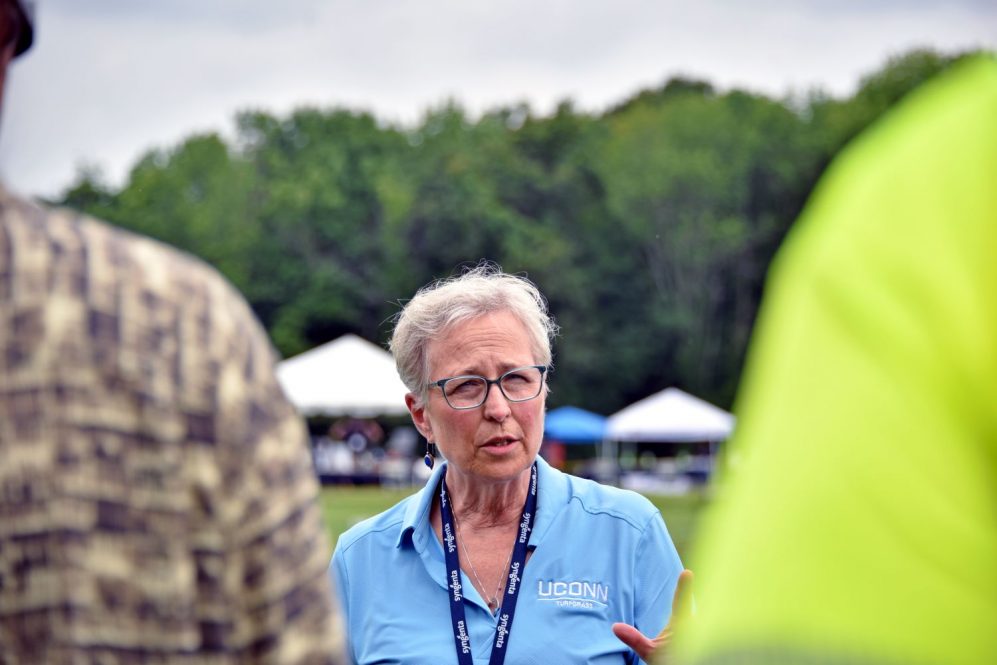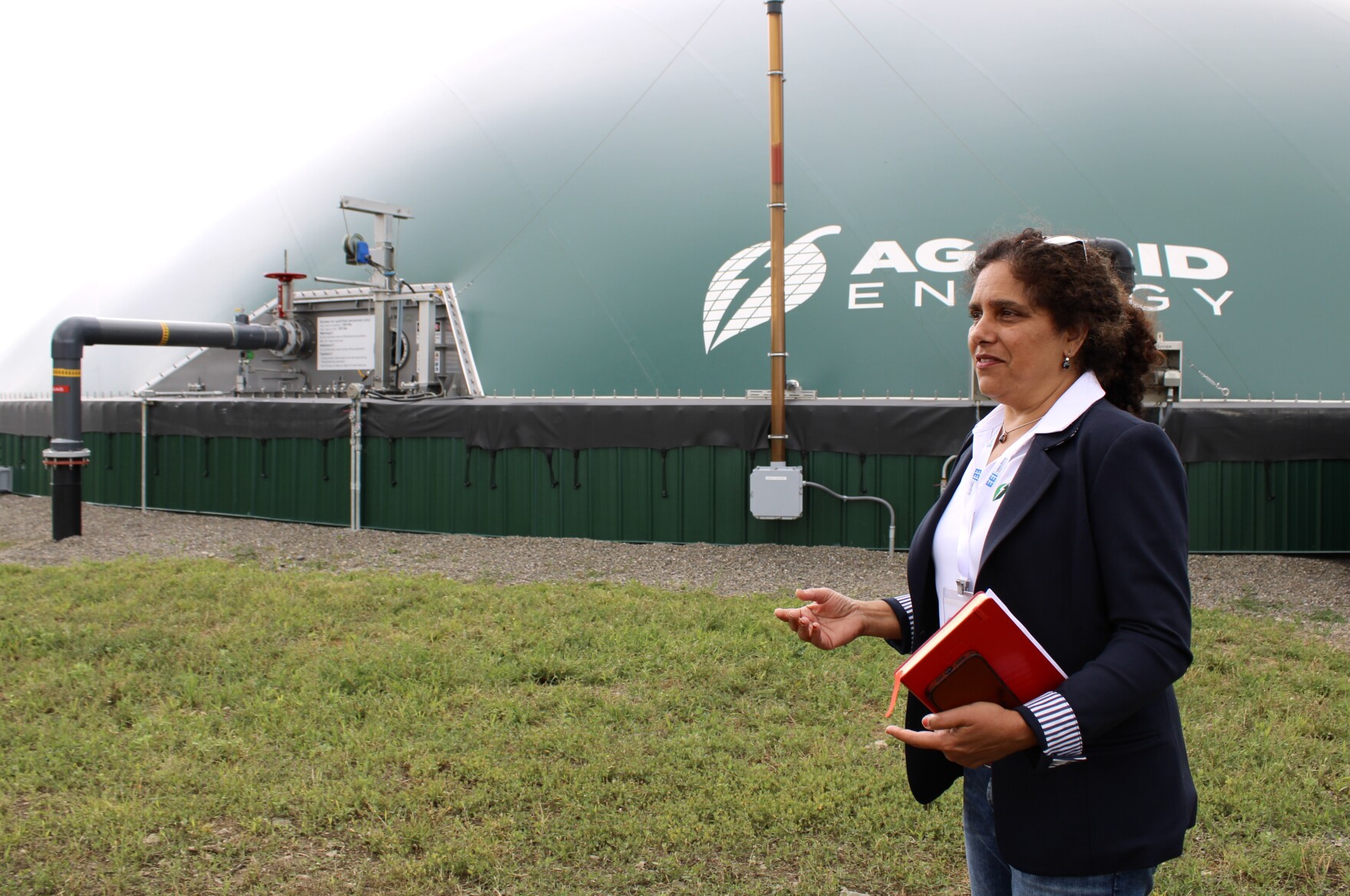The expertise of researchers and extension specialists in the College of Agriculture, Health and Natural Resources (CAHNR) is driving the development of more sustainable turfgrass management practices. The UConn Turfgrass Science Program faculty efforts, in collaboration with industry professionals, have solidified UConn’s reputation as a leader in turfgrass sustainability in the Northeast.
Turfgrass, used for lawns, athletic fields, and golf courses, offers numerous valuable environmental benefits. Turfgrass produces oxygen, helps mitigate soil erosion and airborne particulates, reduces water runoff, filters pollutants from water, lowers surface temperatures, sequesters carbon from the atmosphere and improves soil quality. Additionally, turfgrass contributes to human health and well-being by providing social gathering and recreational spaces, reducing noise, and offering habitat for various small animals and birds.
However, turfgrass professionals in the industry often face criticism for the perceived excessive use of water, fertilizers, and pesticides. In response to these challenges, UConn’s turfgrass research and extension programs collaborate with industry partners to reduce environmental impacts and improve sustainability.
UConn’s Turfgrass Science Program focuses on the principles of integrated pest management (IPM), a widely accepted and scientifically vetted approach that incorporates cultural, mechanical, biological, and chemical management strategies to reduce reliance on traditional pesticides.
Jason Henderson, professor of turfgrass and soil sciences in the Department of Plant Science and Landscape Architecture, developed an innovative, mechanical weed control system, the Weedbine, a completely new device that selectively controls weeds in turfgrass via mechanical activity. Commercially launched in February, the Weedbine offers a sustainable solution for managing weeds in turfgrass.
“We think this device can help a lot of turfgrass managers and landscape contractors, especially in regions where pesticides are restricted or where clients prefer alternatives to traditional chemical treatments,” Henderson says.
In addition to his work with the Weedbine, Henderson is conducting research on the impact of autonomous mowers on turfgrass and soil health. These mowers not only enhance turf quality, but also have the potential to reduce fertilizer inputs.
“Autonomous mowers offer tremendous flexibility and enable crews to redistribute their labor resources on other value-added tasks,” says Henderson.
With the added benefits of lower fuel consumption, minimal noise pollution, and their ability to address labor shortages, the researchers and their industry partners believe these mowers represent a major leap forward in sustainable turf management.
The work has roots in industry collaboration and real-world experiences. A landscape contractor observed notable improvements in turf quality using autonomous mowers and reached out to Henderson for further exploration. In support of this research, Husqvarna, a manufacturer of autonomous mowers, loaned the equipment to facilitate the study.
“This collaboration is an ideal example of how industry professionals, university researchers, and equipment manufacturers can come together to answer questions and solve problems,” Henderson says.
John Inguagiato, associate professor of turfgrass pathology, focuses on diseases affecting turfgrass that reduce the integrity and function of these spaces. His work examines and promotes integrated disease management solutions that optimize turf health and disfavor conditions where plant pathogens thrive.
Growing healthy turf that resists infection and discouraging pathogen populations enables turf managers to reduce the amount of fungicide necessary to keep surfaces functioning. Effectively reducing both environmental impact and costs for turfgrass professionals, a goal of Inguagiato’s program, and that of the golf course superintendents and athletic field managers he works with.
“Sustainability has both an environmental and economic component,” Inguagiato says. “By studying cultural practices and new cultivars, we can reduce fungicide inputs while also lowering management costs.”
Inguagiato is currently investigating how aerification, a practice that removes soil cores, can help control dollar spot, a major fungal disease in cool-season turf. His research has found that aerification and re-incorporation of soil cores into the turf canopy can reduce the severity of this disease by up to 50%. He also studies biological control products, which use bacteria to combat pathogens, to develop more effective, non-chemical fungicide alternatives.
Victoria Wallace, sustainable landscapes extension educator, evaluates turfgrasses for two national programs: the National Turfgrass Evaluation Program (NTEP) and the Alliance for Low Input Sustainable Turf (A-LIST). UConn is the only site in New England for the A-LIST program, adding significant regional value to the initiative.
“Turfgrass selection plays a vital role in a successful IPM program and contributes to environmental sustainability,” Wallace says. “Many new turfgrass varieties are developed to thrive with fewer inputs, offering a solution to climate change challenges while reducing costs.”
By promoting sustainable turfgrass varieties that require less water and fertilizer, professionals can address environmental concerns and save money in the process, says Wallace.
As an educator affiliated with UConn Extension, Wallace, along with other UConn turfgrass faculty, directly engage stakeholders to communicate the latest research findings and support the development of new tools to help them adapt to evolving regulations.
One of their resources is a Best Management Practices guide developed to establish benchmark industry standards with science-based, sustainable practices for water, nutrient, and pesticide inputs among other considerations for the New England states. The effort was a collaboration between turf faculty from UConn and other New England universities along with state golf course superintendent associations.
They also worked on the newly developed UConn Athletic Field Assessment App, which provides school grounds managers and other turfgrass professionals with the opportunity to store field and management data, in order to encourage record-keeping.
In-person programs like the biennial Turfgrass Field Day and the annual School Grounds Workshops provide crucial updates to turfgrass professionals in Connecticut and throughout New England.
Industry partners actively support the program by participating in field research and data-gathering surveys, providing input for outreach programming and offering internships and employment for students.
“We continuously adapt our curriculum to meet the needs of the industry and prepare students to lead sustainability efforts in the turfgrass industry,” Wallace says. “Our graduates return the support by contributing to the field with innovative solutions.”
Peter Gorman, technical representative at Atlantic Golf and Turf and a long-time supporter of the program, worked closely with UConn researchers to develop the Best Management Practices for New England Golf Courses.
“UConn has been a leader in reducing reliance on fertilizers and pesticides, always staying on the cutting edge of sustainable turfgrass management,” says Gorman. “I’m proud to collaborate with faculty and staff to exchange knowledge and work together toward more sustainable solutions.”
This work relates to CAHNR’s Strategic Vision area focused on Fostering Sustainable Landscapes at the Urban-Rural Interface.
Follow UConn CAHNR on social media



